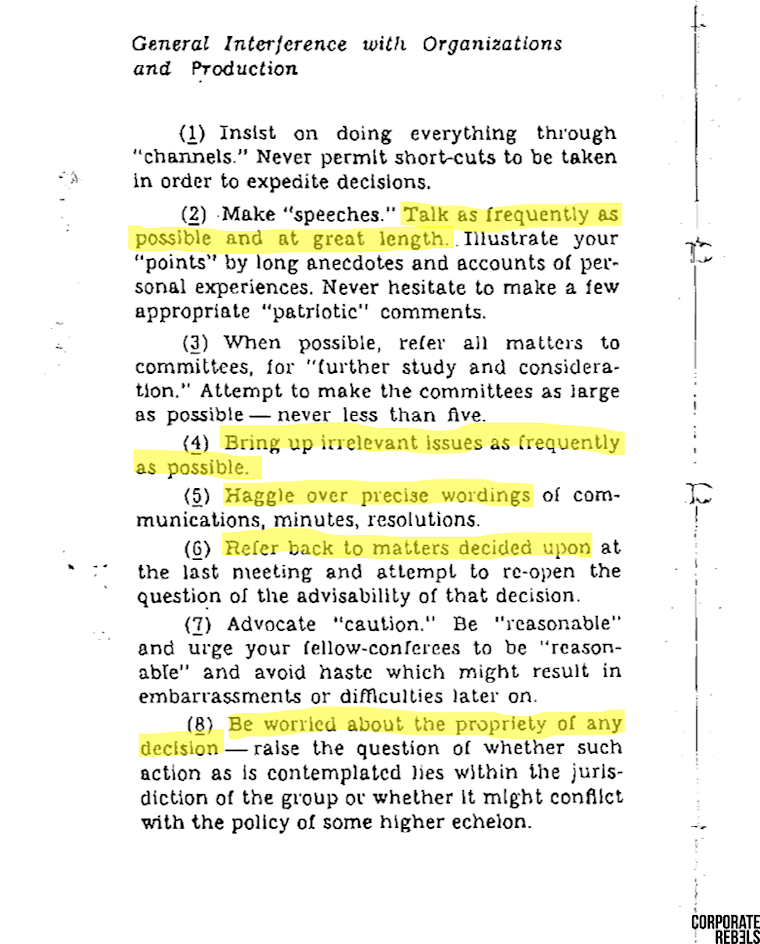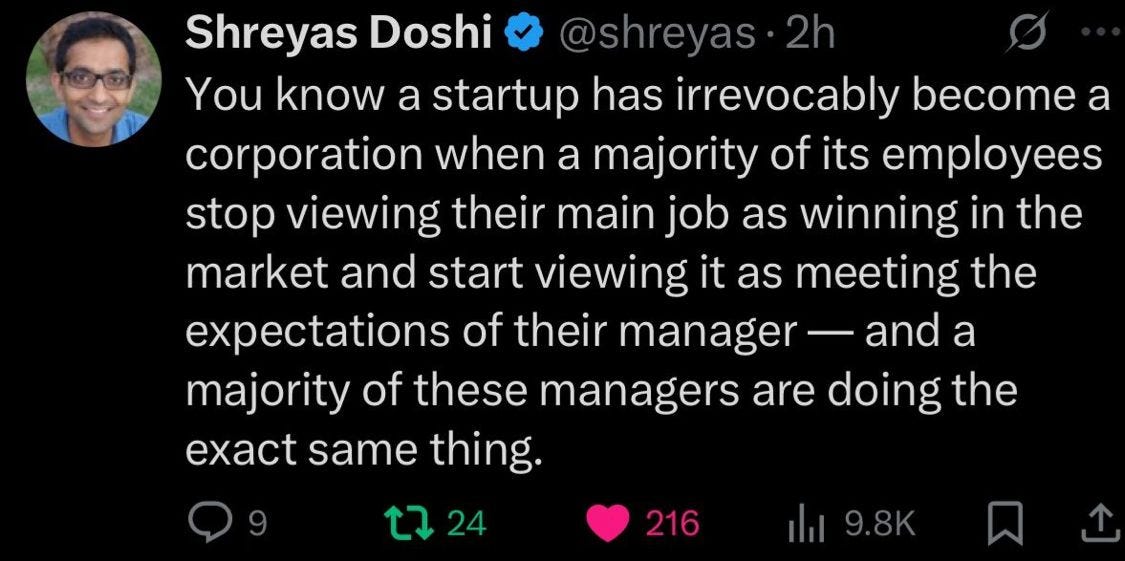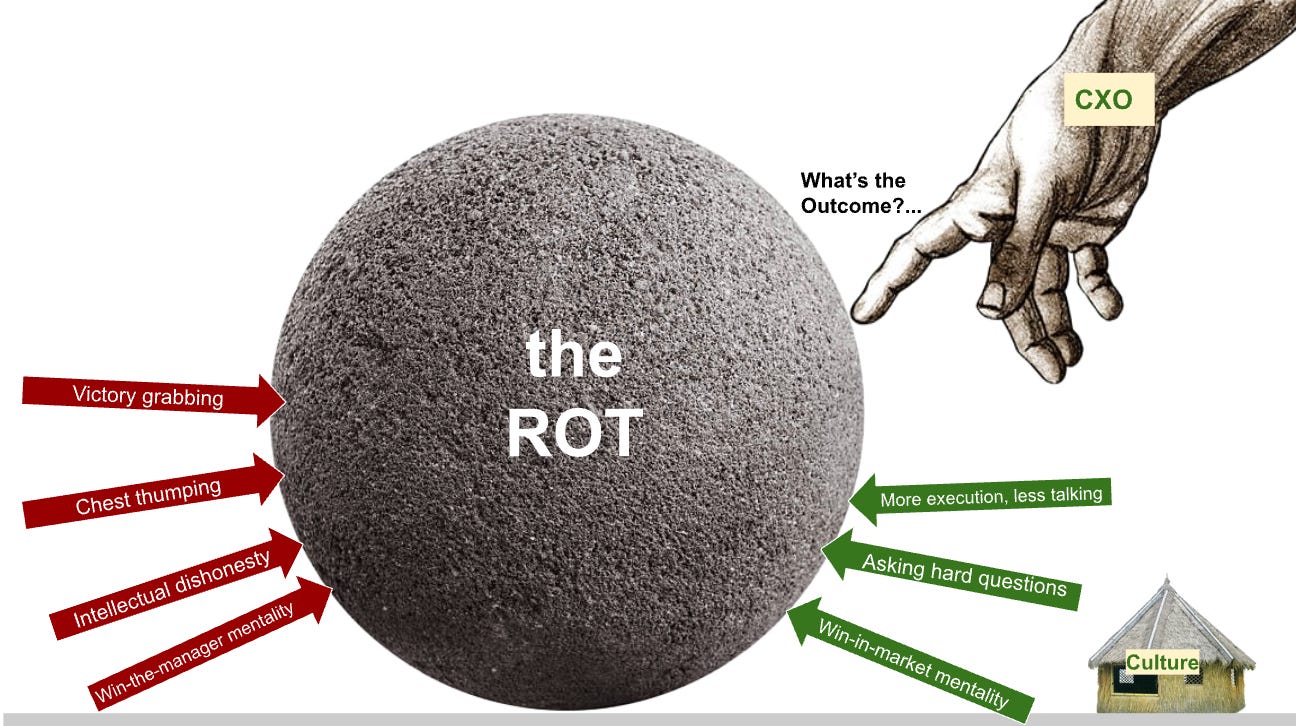Rot, Rhetoric, and the Role of One: Fixing Culture from the Top
Cultural rot doesn’t need a conspiracy—just silence. Here's how it spreads, and how one leader can reverse it.
Some time ago, I came across a post on Twitter that featured a single page from an unnamed book. I was struck by how eerily familiar they felt as I read through the bullet points. They mirrored many of the cross-functional meetings happening at my organization at the time.
My first thought was, “This must be from a management handbook”—perhaps something designed to teach fresh graduates how to run complex, misaligned teams. But then, certain phrases jumped out at me—words like “irrelevant issues” and “haggle.” The tone felt off. Not instructional, but almost... subversive.
As I continued reading, the tweet revealed the source: this wasn’t a management book at all. It was a declassified CIA manual on how to sabotage organizational productivity from within.
That revelation hit me hard.
Because the behaviors described in that manual—endless debates over trivial topics, constant second-guessing, deferring decisions indefinitely—were not only familiar; they were routine in some of the most expensive meeting rooms I had sat in. Rooms filled with highly capable, well-compensated professionals, each unknowingly (or knowingly?) contributing to a kind of silent sabotage. Debating moo points. Circling endlessly. Making sure nothing truly moved forward.
The real question is—why?
For years, I brushed off my discomfort. I assumed it was just my bias. Maybe I didn’t fully appreciate the importance of alignment or following proper protocols. But that tweet cracked something open for me. It made me wonder if the dysfunction I was observing wasn’t accidental or just the byproduct of complexity—but something deeper. Something darker.
In this article, I want to explore:
How these patterns start—and how to recognize them
How a deep cultural rot can create environments where intellectual dishonesty is rewarded
And most importantly, how it can be stopped—and who is best positioned to stop it
The Start of the Rot
As human beings, we’re born with a remarkable instinct: the ability to tell when food has gone bad. A strange smell, a sour taste, a texture that feels off—it doesn’t take training to know something's wrong. That ability likely helped our ancestors survive, keeping them away from what could harm them. But over time, some cultures acquired a taste for what once smelled off—fermented foods, pungent cheeses—turning warning signs into delicacies.
Organizations rot in much the same way.
Most of us can sense when something is off in a room. We may not be able to put a finger to it, but we feel it—a statement that doesn’t quite make sense, a decision that defies logic, or a person cloaking nonsense in articulate & flowery language. Our instincts whisper, “That doesn’t add up.” But just like with the cheese, we learn to live with it. We survive it. And eventually, some of us even learn to thrive in it.
The real decay often begins with a single moment: someone makes a clearly misleading claim, dodges a responsibility, or spins failure into success—and gets away with it. Everyone in the room knows it's wrong. You can almost feel the collective breath being held, waiting for someone—anyone—to call it out. But the person who should intervene doesn’t. Maybe they hesitate. Maybe they’re tired. Maybe they calculate that the confrontation isn’t worth it today.
And just like that, the rot takes root.
The person at the center doesn’t feel out of place—they’ve brought this behavior with them from elsewhere. Like a flu strain. To them, it’s just how the game is played. Their use of flowery language, their mental gymnastics to disguise underperformance, isn’t even seen as deceit—it’s survival. And now, they’ve found fertile ground.
It’s important to distinguish between an organization that has no culture and one that’s quietly rotting from within. The former might be chaotic, but salvageable. The latter is trickier. Rot looks a lot like order—on the surface. But you can always spot it if you know where to look.
Here are some early signs:
The organization is struggling to deliver results, but a small clique continues to rise—getting top ratings, public praise, and promotions—despite no clear, measurable impact. They are the recurring stars of every town hall and congratulatory thread, celebrated by the most powerful voices.
There’s a particular team or group that somehow always dodges the tough questions. Deadlines slip, outcomes blur, but no accountability follows. When cornered, a senior figure steps in to shield them, and the cycle repeats.
The volume of meetings, documents, and Slack threads starts to balloon. High-value individuals—whose time costs thousands of dollars per hour—spend hours debating, drafting, and deferring. Decisions are avoided, not made. Action is replaced with activity.
And slowly, imperceptibly, a shift occurs: people no longer talk about winning in the market. Instead, they speak of meeting expectations—of pleasing their manager, who is busy doing the same with theirs. The goalposts are no longer external. They are bureaucratically inward, nested in a loop of self-preservation.
This is how the rot spreads. Not in explosive failures, but in quiet compromises.
The Rot Progresses
What begins as a moment of overlooked dishonesty slowly metastasizes into something much larger. Left unchecked, the rot spreads from an individual to their immediate team—and then beyond. It forms a micro-culture within the organization, one where optics trump output, and volume outweighs value. It’s no longer about what gets done, but how loudly it can be spoken about.
These individuals and teams grow bolder. They become the most visible voices in the room—quick to take credit for others’ wins, eager to inflate the smallest of tasks into grand achievements. Yet, when things start to unravel, they fall conspicuously silent. They look around for scapegoats, external dependencies, market conditions—anything to shield themselves from blame. And somehow, they continue to be allowed this leeway.
The very people entrusted with protecting the organization's culture—leaders, people managers, senior stakeholders—turn a blind eye. Maybe they’re too busy. Maybe they don’t have the heart anymore. Either way, the rot deepens.
Over time, these actors master the subtle art of failing up. Contrary to the usual interpretation—where someone stumbles upwards through sheer luck or connection—my version of failing up is more nuanced.
It’s the act of throwing your full weight behind an idea, project, or initiative belonging to someone powerful. Even if it’s flawed. Even if you know it’s doomed. You sell it with conviction. You defend it with passion. And when the inevitable failure arrives, the powerful person whose idea you championed feels obligated to protect both the project and you. The narrative is rewritten. The outcome reframed. Your loyalty is rewarded. Promotions follow. Appraisals shine. The system learns: failure is fine, as long as it's aligned.
This rot moves faster—much faster—in startups than in large corporations.
In big organizations, the process acts as insulation. Projects are scrutinized through structured reviews. Metrics are often owned by people outside the team. Results get judged by dispassionate parties. While these layers can be slow and bureaucratic, they also serve as a kind of immune system—filtering out dysfunction before it spreads too far.
Startups, on the other hand, are built for speed. Teams are small, cross-functional, and close-knit. The top decision-makers are accessible to all, and in the best cases, this makes the company agile and responsive. But that same closeness also makes startups vulnerable. HR processes are patchy. Performance reviews are informal, sometimes arbitrary. Boundaries blur. Influence flows freely, often unearned. And without strong checks and balances, charisma can easily override competence.
It’s in this environment that intellectual dishonesty goes from being a red flag to a useful tool. People watch, and they learn. They see how numbers can be dressed up, how half-truths can slide through with enough polish, how performative storytelling beats factual reporting. And when they see those who mastered this art rise rapidly—despite underwhelming outcomes—it triggers something deep. An anxiety. A question.
Should I start playing the same game?
And many do. Because in a system that rewards noise over nuance, it’s only natural to chase the winning formula—even if it means compromising on the truth.
Reversing—and Stopping—the Rot
To be brutally honest, if you're not sitting in the C-suite, your chances of meaningfully reversing a cultural rot are slim to none. Execution can come from the bottom up. Innovation can emerge from any level. But culture? Culture flows from the top—always.
No matter how deeply entrenched the dysfunction is, it never truly comes out of nowhere. It’s allowed to exist. And more importantly, it’s protected—often through inaction.
The good news? Reversing it doesn’t require grand speeches or sweeping restructures. If there is someone at the helm—someone in a position of real authority—who even remotely cares about saving the organization’s soul, the tide can be turned. Not easily, but simply.
It starts with one question. Repeated often. Delivered with quiet consistency.
“What’s the outcome?”
That single question, asked in every meeting, in every review, in every celebratory presentation—cuts through the noise. When spoken by someone who holds real power, it reframes the room. It anchors conversations back to reality. It sets the tone that what matters isn’t effort, intention, or optics—but results.
And if it’s done publicly—not in private Slack threads or behind closed-door 1:1s—it signals a shift. It tells everyone, including those who’ve built their careers on flowery language and narrative spin, that the rules are changing. The reset begins.
But this can’t stop at rhetoric. It has to be backed by hard processes that embed accountability at every level:
Brutally prioritize projects based on alignment to north-star metrics—like unit economics, customer retention, or clear revenue impact. Not vibes. Not vision decks. Metrics.
Demand clarity on outcomes for every investment of time or money. Don’t accept vague answers or proxy metrics. Label projects for what they are: Failures, Moderate Successes, or True Wins—and make that language common, not taboo.
Personally invest in the company’s biggest bets. Senior leaders need to be in the room when these projects are being scoped and planned. They don’t need to micromanage execution, but they must take ownership of direction. Because when culture decays, strategic thinking is the first casualty. Leaders must reclaim that ground themselves.
And yes, in the beginning, it might feel like micromanagement. But that’s what triage looks like. When an infection has spread, you don’t apply a general policy—you take decisive, hands-on action. You clean the wound yourself.
Eventually, as systems are rebuilt and cultural immunity restored, this level of involvement won’t be needed. But until then, it is necessary.
Because in the end, cultures aren’t destroyed overnight. They erode slowly, quietly—through a thousand unchecked compromises. But with intention and courage, they can be restored.
Conclusion: A Culture Worth Defending
Growing up, I watched countless Bollywood films where society was drowning in corruption, crime, and despair—until, suddenly, a hero emerged. The naayak. He’d fight the system, defeat the villains, and restore justice—single-handedly.
But as I grew older, I realized that real life doesn't work that way. Most systemic problems—whether in society or within organizations—are far too complex to be fixed by one person. Real change, I believed, was always a collective effort.
Except… cultural rot is an exception.
Unlike most large-scale issues, this is one fight that can be won by a single person—if that person sits at the top. One leader, with clarity and courage, can reset the tone. Can ask the right questions. Can demand accountability. And in doing so, can undo months or years of silent decay.
It’s rare to find a problem big enough to matter—and yet small enough to solve with a single, consistent act of leadership.
This is one of them.





